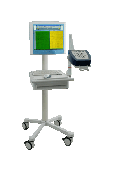|
|
|
|
|
|
 |
|
|
|
The SACS® EEG Workstation is the ultimate solution for routine EEG in both large networks and stand-alone systems. As all SACS® Workstation products it is built on the user friendly, safe and modular SACS® platform. With some modules differing they are basically the same system. The EEG signal is stored in a local SACS® database or in the powerful SACS® Server Database and can be reviewed on any SACS® Review Workstation. A module for digital video can easily be added as well as any other hardware interface, signal processing or presentation modules.
Internal Buffering –
Review and editing during recording session
An internal buffer in the system allows EEG for several hours to be reviewed during the recording session. EEG is represented in the user interface module by a timeline. Marked events, sections with permanently stored EEG and the current position of the EEG windows are displayed on the time line. The time line has zoom and tooltips. Mouse clicking on the time line can position the EEG windows. Paging can efficiently be made by multiple modes. Review and editing during the recording session can easily be made in a separate EEG window.
Permanent storage
Data from the internal buffer can by multiple modes be selected for permanent storage. There is no need for storing data continuously; interesting part can be reviewed and stored within the buffer time. If a section of the recording is permanently stored or not is clearly shown by multiple indicators.
Event marks
SACS® Workstation offers five main types of event that the user can add to the recording.
1. Momentary events e.g. swallow.
2. Flexible user defined momentary events. The user defines the event, which can be used for the current recording.
3. States, e.g. wakefulness, status of the eyes and head position. The states are grouped and the values in each group neutralize each other. The states for the current EEG window can be displayed.
4. Free text notations.
5. Clips, for use as bookmarks.
Events can be added, moved and removed as long as a recording or a review session is open. When a recording or a review session is closed no event can be changed to ensure medico legal safety. All events and changes can be traced.
Technical Data
Preamplifier
Inputs:
34 inputs (27 EEG, 6 polygraphic, 1 respiration
Input impedance:
100 MOhm
Input noise:
< 1,5 microvolt
Common mode rejection ratio:
>100 dB at 50 Hz
Electrode impedance measuring:
LED and screen display,
Limit values selectable
5-10-20-50 kOhm
Signal transfer:
Digital via optical fiber cable, electrical separation from the instrument.
Cable:
Standard 5m, maximum 25m without additional amplifier
Sampling frequency:
125 - 1000 Hz
Resolution:
16 bit
Photic stimulator
Program:
Software controlled.
Customized design
Flash energy:
Approx. 0.4 Joule/flash, 50 flash/s
Approx. 0.7 Joule/flash, 35 flash/s
Approx. 1.0 Joule/flash, 25 flash/s
Software:
Operating system Windows NT 4.0
Computer
Processor Pentium III 733 MHz standard, needs > Pentium 133 MHz
Hard disk 9 Gbyte
Memory 128 Mbyte
Graphics Matrox G400, 16Mbyte
Monitor 21” CRT w. resolution 1600x1280 or 18.1” flat panel w. resolution 1280x1024
Archive
SACS® Server database or CD/DVD-RW
|
|
|
|
|
|
|
|
 |
|
|
|
Montage
There can be an unlimited number of user-defined montages. In common average montage a powerful tool for artifact rejection can be used.
Data storage in a powerful database solution
The database solution is highly scalable to fit all needs from stand-alone system to networked solutions serving large hospitals, regions or commercial health care organizations. All data are compressed and stored within the database, which makes storage and communication safer and access faster and more reliable compared to EEG stored in files administrated by databases. The SACS® Server Database is a true server database, which offers the ultimate performance needed in digital EEG.
Data can be reviewed on one or many remote SACS® Workstation during the recording session.
During a review session the EEG sections to be archived are easily marked and data reduction is perform very fast. A recording with marks for data reduction can be reviewed ‘as reduced’ prior to the actual reduction.
Database interface supports workflow.
The database interface works like the Windows Explorer interface. The tree structure can be set up to reflect the workflow at the laboratory and it is possible to move recordings by drag and drop technique. The database interface can also be run as a stand-alone program.
Signal measurement cursor
Measurement cursor gives numbers on actual time, time intervals, amplitudes, and frequencies.
Impedance measurement
Electrode impedance can be measured on demand. It is also measured at the start of every permanently stored section. Each EEG sample refers to the last valid impedance measurement. The display can be set-up to warn for high impedance levels.
Multiple display windows
There are no limitations in how many display windows that can be used. Different montage and filter setting can be shown in different windows. All windows can be synchronized.
Export and Import
Export and import can be customized to any defined file format.
Review
SACS® Review Workstation software can be installed on almost any PC running Windows NT operating system. Built on the SACS® platform it is basically the same system as the recording system. The modular design makes it possible to add analysis modules, e.g. frequency analysis. The fast data access from a local database or from a SACS® Server database allows paging in more than 40 times real time.
|
|
|